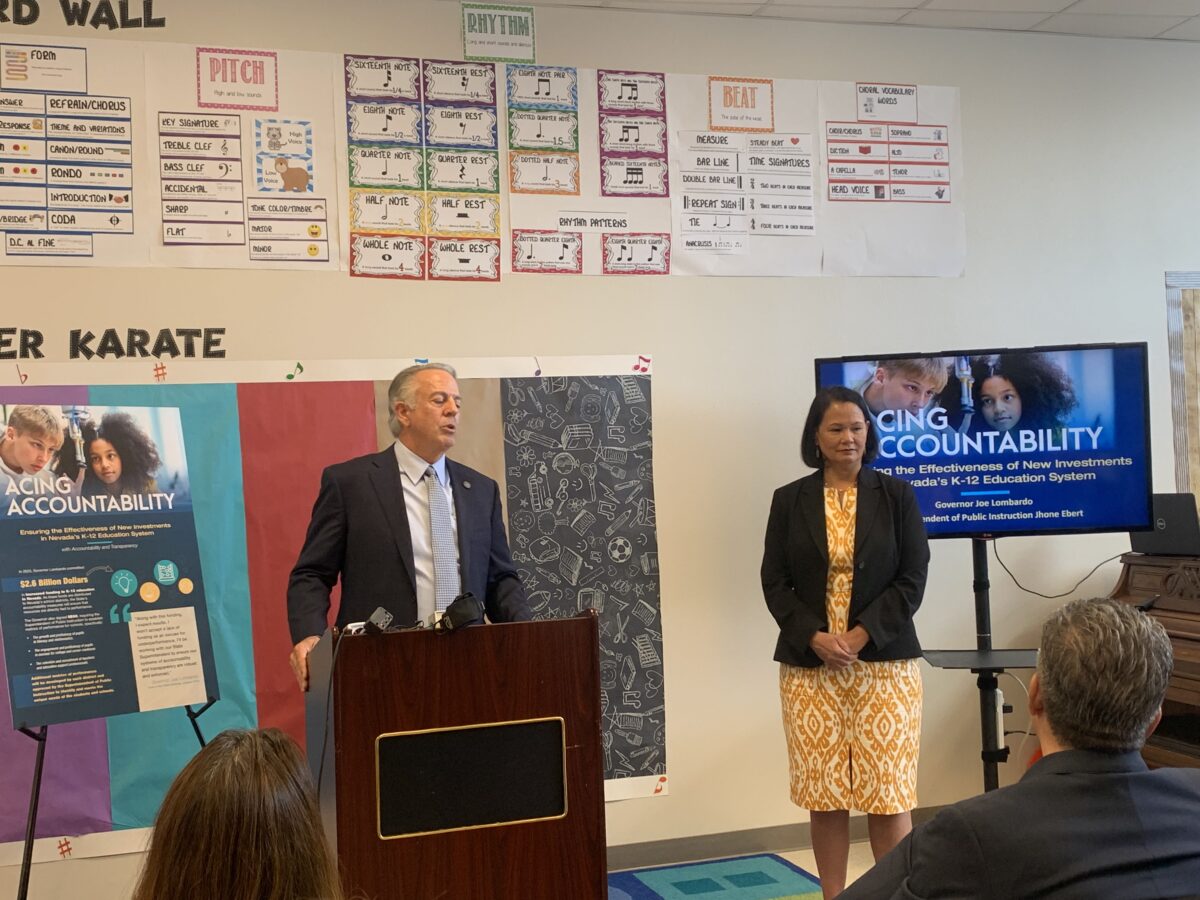More than a week after he was fired in light of potential budget deficits at schools and districtwide — and amid panic that layoffs could be in order — Jason Goudie, the Clark County School District (CCSD)’s former chief financial officer, maintains the issues that are attracting scrutiny from the highest levels of state government weren’t because of mistakes made by him and his team.
Instead, Goudie attributes the issues to financial constraints caused by the Clark County Education Association (CCEA)’s historic contract — which included 18 percent salary increases spread out through two school years — a deal he said the district was under pressure to accept.
“It wasn’t that the contract was unaffordable,” he said in an interview with The Nevada Independent. “It was that it spent virtually everything we had and so that any blips that we have are going to cause a potential deficit.”
School principals began sounding the alarm earlier this month after they were informed by the district that raises for teachers weren’t fully baked into the dollar amounts they were told they would receive for this school year. In addition, the district said in a Sept. 20 memo that it identified a potential deficit in its central budget separate from schools during its regularly scheduled year-end close-out accounting process.
That possible deficit stems from unanticipated expenses for litigation and cybersecurity and doesn’t affect schools’ separate budgets, the district said Friday.
The situation remains murky, though. As of last Friday, the district said it hasn’t been able to confirm whether a central budget deficit exists, and the teachers union is also questioning the existence of a shortfall in the first place.
Goudie said his team also faced a tight turnaround to get preliminary budget forecasts to schools by Jan. 15, about a month after the contentious teacher contract negotiations concluded in December. This deadline is written in the 2017 so-called CCSD reorganization law that vested individual schools with more budget authority. He said the time constraint forced his team to build preliminary school budgets with estimated average teacher pay costs that turned out to be lower than the actual amount.
The issue caused panic throughout the district with reports of schools’ budgets potentially being in the red, which could force them to make cuts in staffing and programs. Union leaders and state officials are demanding more information on why the potential problem wasn’t identified sooner and how it came to be.
In the Sept. 20 memo, interim Superintendent Brenda Larsen-Mitchell committed to provide assistance to schools that can’t plug the potential holes in their budgets on their own.
During a press conference last Friday, the Clark County Education Association (CCEA) questioned whether a deficit actually exists given the historic increase in K-12 education funding passed in 2023. Lawmakers also approved an additional $250 million to create a matching fund to support salary increases for educators. CCEA Executive Director John Vellardita accused the district of “sitting on the money.”
On Thursday, State Superintendent of Public Instruction Jhone Ebert sent a letter demanding information about the potential budget shortfall. She gave Larsen-Mitchell until Oct. 3 to respond to a list of questions, including what caused the incorrect assumption and the approximate amount of the shortfall.

Additionally, on Friday, Republican Gov. Joe Lombardo sent a letter to Democratic Senate Majority Leader Nicole Cannizzaro requesting that the district’s current budget issues be added to an ongoing legislative audit into certain school districts, including CCSD, required as part of the 2023 bill. He wants to know what actions the district, the Legislature and his office can take to prevent this from happening in the future.
Lombardo also noted that any attempts to mitigate the shortfall that violate the reorganization law, including failing to transfer 85 percent of the district’s unrestricted funds to schools or accessing their year-end carry-forward balance, is prohibited.
“We are concerned with reports that CCSD’s current budget issues will potentially result in the release or elimination of teachers and other staff positions,” said Lombardo, who has touted his support of major increases to education budgets last year and has sought a reputation as an education governor.
“Given last session’s unprecedented increase in funding for education, such a scenario would be unacceptable.”
Lombardo also sent a separate letter to the state Department of Taxation asking for the Committee on Local Government Finance to take action to evaluate the district’s budget crisis.
The school district said in a Friday statement that it welcomes expanding the scope of the audit, and the opportunity to respond to Ebert’s questions, as well as any other inquiries it may receive.
Goudie said in a Wednesday interview that he doesn’t think such an investigation will help because funds weren’t mismanaged, and said the additional funds from the Legislature are in the district’s $3.6 billion budget — $2.4 billion of which was distributed to schools.
“So that’s where the money is,” he said.
Underestimating costs
In 2017, AB469 “reorganized” the school district by designating each school as a precinct and empowering them to have autonomy over their budgets.
The bill requires CCSD’s superintendent to estimate its annual funding and then how much will be allocated to schools on or before Jan. 15 for the upcoming school year — a deadline that Goudie referred to as arbitrary.
The allocation each school receives is based on its number of students and additional funding known as “weights” for at-risk students, gifted and talented students and English language learners. These estimates are used to inform school’s staffing decisions.
The law also requires each school’s allocation to be adjusted on or before Nov. 1 of each year to update its actual student enrollment numbers.
Goudie said preliminary school budgets are typically built based on assumptions around student enrollment and average teacher pay costs, including benefits. But that work was complicated this year due to the prolonged CCEA contract negotiations, which weren’t concluded until December, weeks before the Jan. 15 deadline.
He said in previous years, teacher contracts have been settled months before the end of the calendar year, giving his team enough time to analyze payroll data and make more accurate school budget forecasts.
“But when the deal is signed at the end of December, it’s very challenging to go through and analyze all that data, and we did analyze it; we did the best we could to estimate what we forecast the new number to be, and it was still low,” he said.
Because of this, Goudie said his team estimated the total average teacher salary cost to be $115,000, about $5,700 lower than the actual number of about $127,000. This means that schools were allocated less money than they needed to pay for teachers’ salaries and benefits.
But Eva White, a former CCSD interim chief financial officer, said in an interview with The Nevada Independent that Jan. 15 deadline was traditionally used by the district even before the reorganization law was passed, and was added into the bill’s language from district input.

Late notice?
Jeff Horn, executive director of the Clark County Association of School Administrators and Professional-Technical Employees, said principals use the budget forecast they receive in January to inform their staffing decisions for the upcoming school year. They were unaware until recently that they were built with average teacher costs that didn’t fully reflect the new raises for teachers.
“Nothing was given to principals until the school year started and all the hiring had taken place,” Horn said.
A budget planning document with a summary of average employee salaries as of Jan. 15 suggests that the pay increases were included in the projections for fiscal year 2024.
Horn questioned why Goudie or the district didn’t inform principals sooner that their budgets for the 2024-25 school year might be off, especially before they started their hiring process, so they could plan accordingly.
“I don’t see an excuse for that at all,” he said. “This is his sole job, to figure this out … and make sure principals had accurate data, or at least as accurate as could be.”
When asked why the district didn’t give schools notice that their allocations weren’t made with accurate average cost of teachers, Goudie said there was “a lot of things going on” during the first months of year such as former Superintendent Jesus Jara’s resignation and the appointment of Larsen-Mitchell as the interim superintendent.
“Not that’s an excuse … communication can always be done differently,” he said. “But again, I’m not sure what else they’re going to do with that information given the fact that they have their employees, they’re still going to have to make changes at a later date anyway.”
What’s next
While there’s no way to control how long contract negotiations can take, Goudie said one thing that lawmakers could do to make the budgeting process easier for the district is reconsider the Jan. 15 deadline when the district has to submit budget estimates to schools.
“We’re the only district in the entire state that is required to do that,” he said. “I think that’s one thing that could be addressed to help mitigate, not going to alleviate, but mitigate the situation in the future.”
Goudie also cited a component in the reorganization law that allowed schools to retain any funds they don’t spend; the district can’t reclaim them and use them for a districtwide shortfall or redistribute them, which he said he has long disagreed with. Goudie said CCSD schools have a total of $365 billion in unspent funds that is, in part, due to staffing vacancies that they can carry forward and spend in future school years.
Under a 2023 state law, SB282, if the year-end balance carried forward by a school precinct exceeds 5 percent of actual expenditures in the immediately preceding school year, that amount must be used on programs such as tutoring or social and emotional learning. If such funds are not spent within two years, they must be deposited in the Education Stabilization Account.
Goudie said it would be better if that money could be transferred to the district’s central budget instead.
“We can initiate different programs, cover salary increases in different ways, and do a whole number of things that we need to do,” he said.

